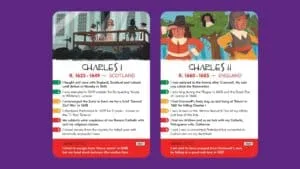King Charles’ through history: The Coronation of King Charles III
As we approach the Coronation of King Charles III on Saturday 6th May 2023, journey with History Heroes through the reigns of the two King Charles’ who came before him!

Charles I and Charles II History Heroes cards
The first Charles: King Charles I
In 1625, Charles I came to power. Along with deeply unpopular taxes and failed wars, Charles I is known for clashing with Parliament throughout his reign, leading to his (spoiler alert!) beheading in 1649.
But let’s head back to the beginning. Charles I was born in Scotland in 1600 – the second son of James VI of Scotland (and James I of England) and Anne of Denmark. In 1625, Charles I became the second Stuart King – and a controversial one at that.
Charles I, like many monarchs, firmly believed in royal authority and the divine right of kings – the belief that monarchs were chosen by God. At the time people were deeply divided by this idea and his extreme expenditure at court, which made him extremely unpopular with the public at large.
But Charles I wasn’t all bad. He was a big fan of fine arts. He invited Anthony van Dyck and Peter Paul Rubens to work in England, and bought a collection of paintings by Titian and Raphael. Are these Artists History Heroes ringing any bells? Check out our ARTISTS pack or explore our online quiz!
Tensions between Charles I and Parliament were made worse by his finances. Charles I’s marriage to Roman Catholic, Henrietta Maria of France, also felt politically provocative – with the plots against Elizabeth I and James I were still very much alive in England’s memory.
In 1629, Charles dismissed his Parliament, deciding to make do without its advice or taxes. This began a period of time which would be dubbed (by Charles I critics) the 11 Years’ Tyranny. Charles had to find alternative means of income, so he forced loans and introduced duties on trade known as impositions. This made him even more unpopular, turning even royalists against him.
Charles I called another Parliament in 1640, which was very quickly dissolved and recalled in the same year. This new Parliament became known as the Long Parliament. By this time, civil war had broken out in Scotland in 1637, and would break out in Ireland in 1641. A year later the English civil wars began, marking the beginning of the end for Charles I.
On 20 January 1648, during the second English Civil War, Charles I was charged with high treason. A week later, he was sentenced to death, and was beheaded in Whitehall, London.
Do you know the key player in the fight against King Charles I?
Oliver Cromwell of course! And after 11 years of Parliamentary rule under Cromwell, Charles I’s son, Charles II became King in 1660, bringing the republican government’s rule, with Cromwell as its Lord Protector, to an end.
The Merry Monarch: King Charles II
King Charles II was only 8 years old when the Civil War broke out, and in 1651 he was crowned King in Scotland. He would spend the next 9 years in exile in France, the Dutch Republic and the Spanish Netherlands. Eventually, he returned to London as King.
The early years of Charles II’s reign were categorised by public spectacle. He quickly became known as a king with a flair for extravagant parties and as a lover of women! Despite having many mistresses, he married Catherine of Braganza, daughter of King John IV of Portugal in 1662.
Charles II’s reign, known as The Restoration, marked a return to normalcy after the tumultuous years during and following his Father’s reign. Known as the ‘Merry Monarch’, Charles II was known for his charm, wit and fun, as well as presiding over a period of cultural and scientific achievements, such as the founding of the Royal Observatory in Greenwich.
However, it wasn’t all good news. One of the most significant events of Charles II’s reign was the Great Fire of London in 1666 which destroyed much of the city. The King played an important role in the city’s recovery, overseeing the rebuilding effort. Do you know which History Hero documented the events of the Great Fire of London in his diary? Samuel Pepys! Check out more about Pepys in our LONDON Pack.
King Charles II died as a result of a stroke in 1685, having served as monarch during the rebuilding of royal and parliamentary peace… and leaving behind at least 14 illegitimate children!
A new King: King Charles III
On Saturday 6th May 2023, King Charles III will be crowned. But what can we expect from this reign?
Well… Prince Charles has actually already broken a couple royal records. Charles is the oldest heir to the throne in British history, having waited longer than any other heirs, to assume the role of monarch. Charles is also the longest-serving Prince of Wales, having held the title since 1958.
Charles was born in 1948 at Buckingham Palace, and was 3 years old when his Mother, Queen Elizabeth II, acceded to the throne in 1952. In 1981, he married Lady Diana Spencer and had two sons William and Harry. In 1966, Charles and Diana divorced. During this period in history, the royal family was in the public eye more than ever before; with newspapers, television and radio coverage, Charles came under widespread scrutiny. A year later, Diana was tragically killed in a car crash in Paris.
In 2005, Charles married his long-term partner, Camilla Parker Bowles, now the Queen Consort. Although we can’t yet assess Charles III’s influence as a king, he has made clear his passions and concerns over the years. As heir apparent, Charles has taken on a number of duties and engagements. He founded the Prince’s Trust in 1967 to develop and support young people’s skills; he has been instrumental in the development of the organic farming movement and he has campaigned passionately for action on climate change and the protection of the environment. He is also patron or president of over 70 arts organisations.
The first King Charles was a great patron of the arts but was a deeply unpopular king, who believed way too passionately in the divine right of Kings. The second King Charles was popular and charming. He was a patron of science and his tolerance of different religions helped maintain stability during his reign. In the end, however, he was a little too much of a ‘Merry Monarch’ to leave a positive, lasting impression on his people.
Will it be third time lucky for the UK and a new Carolean era? Will Charles III manage to embody Charles Darwin’s theory of evolution (yes, of course Darwin is in our SCIENTISTS game – have a look) by evolving into a new and improved version of a King Charles? His predecessors may have set the bar quite low in any case, but as long as Charles III continues to champion his thoughtful, caring and popular causes, he should at the very least…keep his head!
Journey on to all things Coronation…


